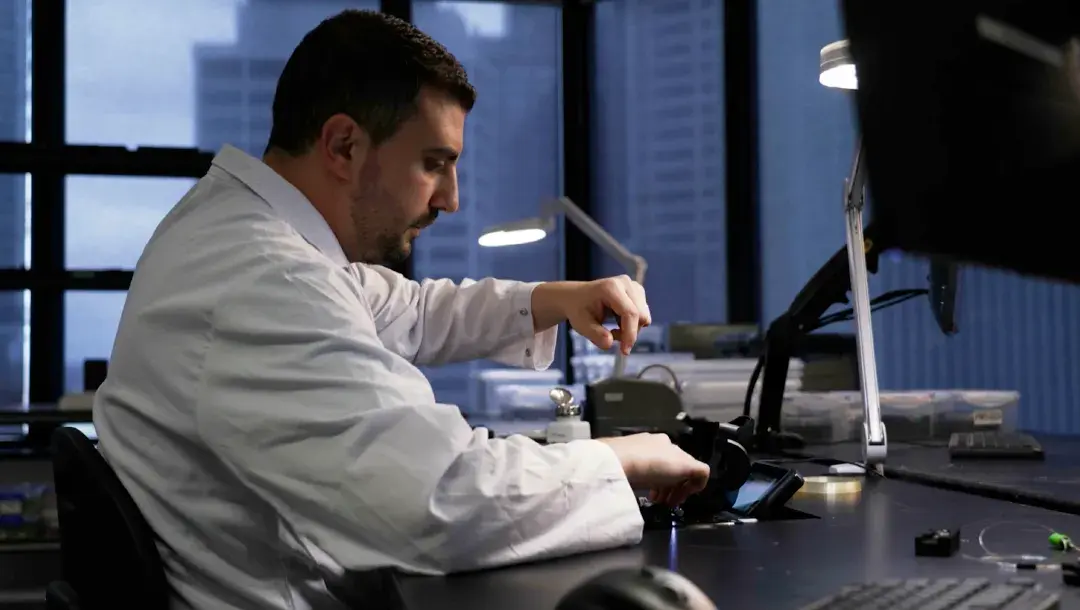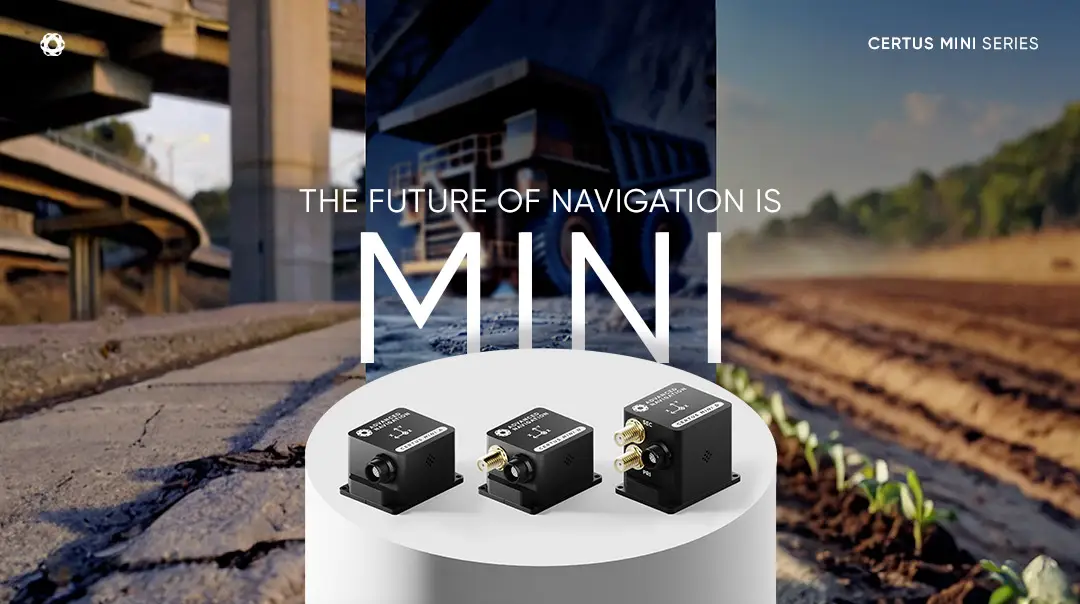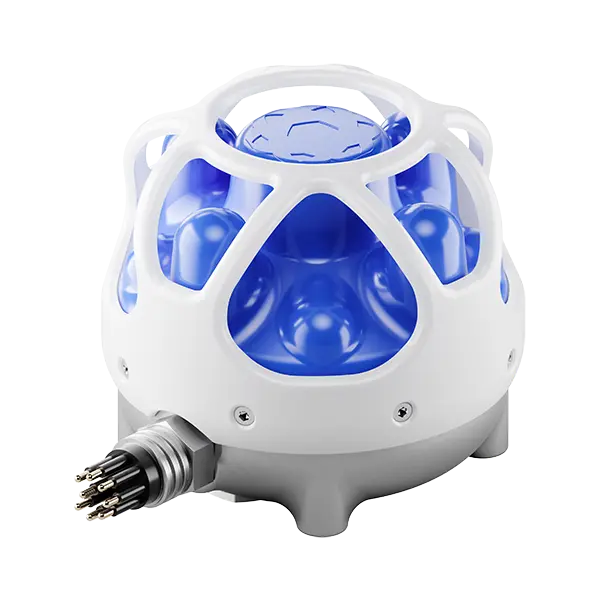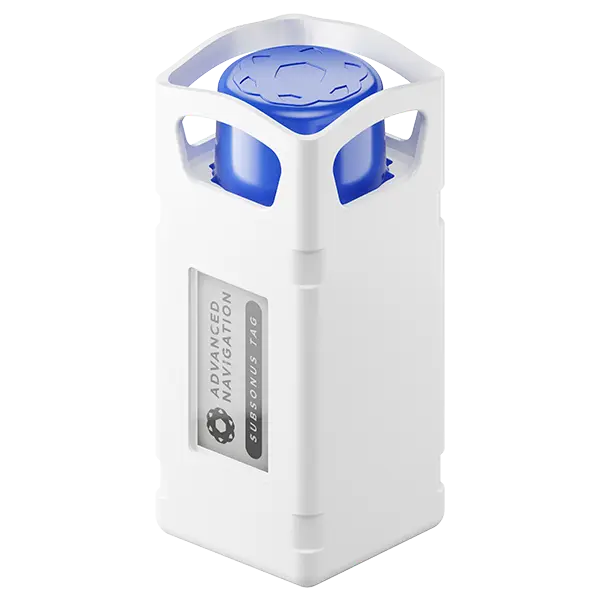Acoustic Navigation
USBL and Integrated Inertial Navigation Systems for Subsea Navigation
Advanced Navigation leverages cutting-edge technology and manufacturing techniques to offer underwater acoustic positioning solutions with the highest performance for the lowest SWaP-C (size, weight, power consumption, and cost). Our range of acoustic navigation products is built on our core knowledge of operating in demanding, GNSS-denied environments. Subsonus combines an industry-leading hydrophone array with advanced AI-based acoustic processing techniques to offer a high-performance ultra-short baseline (USBL) positioning system in a miniature 1000 m depth-rated enclosure.
All processing is performed within the transducer head, removing the need for cumbersome cables and additional processing units – one Ethernet cable is all that is required, dramatically reducing mobilization time. Tightly coupled with the acoustic array is an inertial navigation system (INS), making calibration simple and integration of third-party systems such as Doppler velocity logs (DVL) simple one-click operations. Sophisticated acoustic processing determines the speed of sound at the transducer face in real-time, ensuring range and angular measurements are always high accuracy and removing the need for third-party velocity probes.
Also in our acoustic navigation solution is Subsonus Tag, a next-generation acoustic transponder/beacon. This product advances pressure-tolerant electronics manufacturing to a point where the device is capable of operating at depths of 2000 m and does away with the need for expensive, fault-prone pressure vessels and bulkhead connectors. Subsonus Tag uses standard Qi wireless charging and Bluetooth® for configuration, making the whole system powered and configured with a smartphone and charger. The 28 Wh battery makes Subsonus Tag flight-safe while also offering an industry-leading 18 months of passive endurance. Thanks to the acoustic processing power offered in Subsonus, the Subsonus Tag units can operate on an unlimited number of channels. This makes very large-scale deployment of beacons simple and without the worry of frequency clashes.
For operations where a higher level of performance is required – USBL2
The innovative USBL2 (“USBL-squared”) configuration is recommended. In this mode, unique to Advanced Navigation, a Subsonus transducer is installed on the tracked object, such as an ROV or AUV, as well as an on the surface unit.
By leveraging the AI data fusion algorithms pioneered by Advanced Navigation, data from the two transducers is used for performing USBL calculations at both ends of the positioning system. This offers considerably higher levels of performance than any portable USBL system on the market, regardless of price.
Another benefit of USBL2 mode is that the heading of the surface vessel can be acoustically transferred to the tracked Subsonus units – this provides heading accuracy over an order of magnitude better than a magnetic compass. USBL2 negates the need for a secondary heading solution, such as a gyrocompass, and is immune to magnetic interference.
For operations such as asset or diver tracking
The standard USBL configuration is recommended, that is, a Subsonus unit mounted on the surface vessel, tracking a Subsonus Tag on the remote unit.
Our Acoustic Navigation Positioning Solutions
Advanced Navigation’s range of acoustic navigation equipment is the culmination of years of deep research into acoustic wave propagation and AI signal analysis. It enables navigation solutions to be deployed in new and innovative ways that result in a much simpler, more cost-effective user experience while still offering the highest performance in positioning accuracy.
Subsonus
Revolutionary USBL and INS
Position Accuracy
0.1 m
Roll & Pitch
0.1 °
Acoustic Heading
0.3 °
Range & Depth
1,000 m
View Solution
Subsonus Tag
High-endurance subsea transponder
Position Accuracy
0.25 m
Range
1,000 m
Depth Rating
2,000 m
Battery Life
18 months
View Solution
The Latest News, Articles & More

Decoding Earth’s Fingerprints: Advanced Navigation and MBDA Collaborate on Breakthrough Resilient Navigation Technology
20 November 2024
Go to Article
The Future of Navigation is Mini: Unveiling the Certus Mini Series with INS and AHRS
25 September 2024
Go to ArticleCommon Questions about Acoustic Navigation
What is underwater acoustic positioning?
Underwater acoustic positioning is a method of providing relative and absolute positioning for the purposes of underwater navigation in the absence of GNSS satellite signals.
Acoustic signals are sent between a surface vessel and a subsea system such as an autonomous underwater vehicle (AUV), remote-operated vehicle (ROV), or a diver, and the relative position can be ascertained. When combined with a surface positioning system such as GNSS on the surface vessel, an absolute position for the underwater system can be derived.
Why use an acoustic navigation positioning system?
There are many scenarios where a reliable underwater acoustic positioning system is necessary. From hydrography to harbor maintenance, AUVs and ROVs need accurate positioning data in order to complete their tasks efficiently. However, operating underwater poses significant challenges in terms of positioning.
GNSS signals cannot penetrate beyond an inch below the water’s surface. While GNSS can be used before and after a vehicle submerges, this isn’t a reliable method for underwater positioning, especially at great depths when regular surfacing is not viable for underwater operations. Similarly, radio waves and light also operate at frequencies that are too high to travel through water.
Acoustic signals have a much lower frequency than GNSS, operating at 30 kHz. This lower frequency allows for travel through much greater distances of water. Similar to how whales communicate, these acoustic signals allow us to send data between underwater transponders to determine positions.
How does underwater acoustic positioning work?
Underwater acoustic positioning systems utilize sound waves or acoustic signals to perform positioning utilizing a technique known as Ultra-Short Baseline, or USBL. A device known as a hydrophone functions like an underwater microphone and speaker, and transmits and receives the acoustic signals used in the USBL.
A device known as a USBL transducer is what is created when an array of hydrophones is manufactured with very precise distances and geometries between the individual hydrophone elements.
When an acoustic signal is received by the USBL transducer, the hydrophone elements act as a cluster of GNSS satellites with the received acoustic data being used to calculate the bearing to the source of the signal. Using knowledge of the speed of sound through water, the range between the USBL transducer and the acoustic signal source can also be derived.
To coarsely calculate the bearing between the USBL transducer and the acoustic signal source, the difference in arrival time of the acoustic signal is recorded at each hydrophone, and the known geometry of each hydrophone is used to back-calculate the source of the acoustic signal. This calculation can be improved and refined in several ways. Increasing the number of hydrophone elements in the USBL transducer, and having varied geometry between the hydrophones, particularly in three dimensions, will typically improve the USBLs ability to resolve the source of the acoustic signal.
The next method to improve the calculation is to utilize an encoded acoustic signal, rather than a simple wave-form. As the acoustic wavefront moves over the hydrophones, the ability of the USBL to resolve a complex signal in the acoustic wave allows a technique called phase-differencing to be used to better resolve the difference in arrival times of the waveform, and thus improve the precision of the calculations.
Finally, the USBL calculation may be improved by resolving the bearing in both directions, instead of just one. In simple USBL systems, the USBL transducer is the resolving the position of a simple acoustic source or transceiver. In more complex USBL systems two transducers may be used, with both being used to resolve the relative bearing. Data is shared between the transducers, either via acoustic modem or via a wired network, to allow the two bearings to be included in the calculations.
Based on the USBL calculations, the bearing and range from the transceiver are known, giving a relative position from the transceiver to the acoustic source. In some scenarios this is sufficient information, however, most scenarios require an absolute position of the tracked object, be it an ROV, AUV, or diver. This is achieved using an absolute positioning source such as GNNS, combine with attitude and heading knowledge of the surface vessel, to translate the absolute GNSS position from the antenna to the USBL transceiver. This absolute position is then used in conjunction with the USBL range and bearing to determine the absolute position of the tracked object.
What makes a better USBL?
The accuracy and precision of USBL systems can be improved in several ways. For example, increasing the number of hydrophone elements in the transducer will provide more data that makes directional calculations more precise. Also, varied geometry between the hydrophones, particularly in a three-dimensional sense, will typically improve the USBL’s ability to resolve the source of the acoustic signal.
Another method to improve precision is to utilize a wideband, or encoded acoustic signal, rather than a simple waveform. Using a complex acoustic signal allows the USBL to better apply phase-differencing as the acoustic wavefront moves over the hydrophones. Phase-differencing improves the USBL’s ability to accurately resolve the difference in arrival times of the waveform, which improves the precision of the calculations.
It could be said that the larger the baseline distances and the greater the number of hydrophones, the easier it is to resolve the source of an acoustic signal. However, this typically increases the physical size of the USBL, which in most cases is very undesirable as it can increase the complexity of deployment and cost. To miniaturize a USBL device represents several engineering challenges, which is to not only decrease baseline distance without affecting hydrophone performance but to improve signal processing to maintain accuracy from a smaller baseline. The Subsonus USBL is an example of meeting these challenges, where the unit is so compact that it can be used in a unique dual USBL configuration (USBL-Squared). This configuration uses a USBL on the surface vessel and tracked asset to improve accuracy by resolving acoustic signals at both ends.


